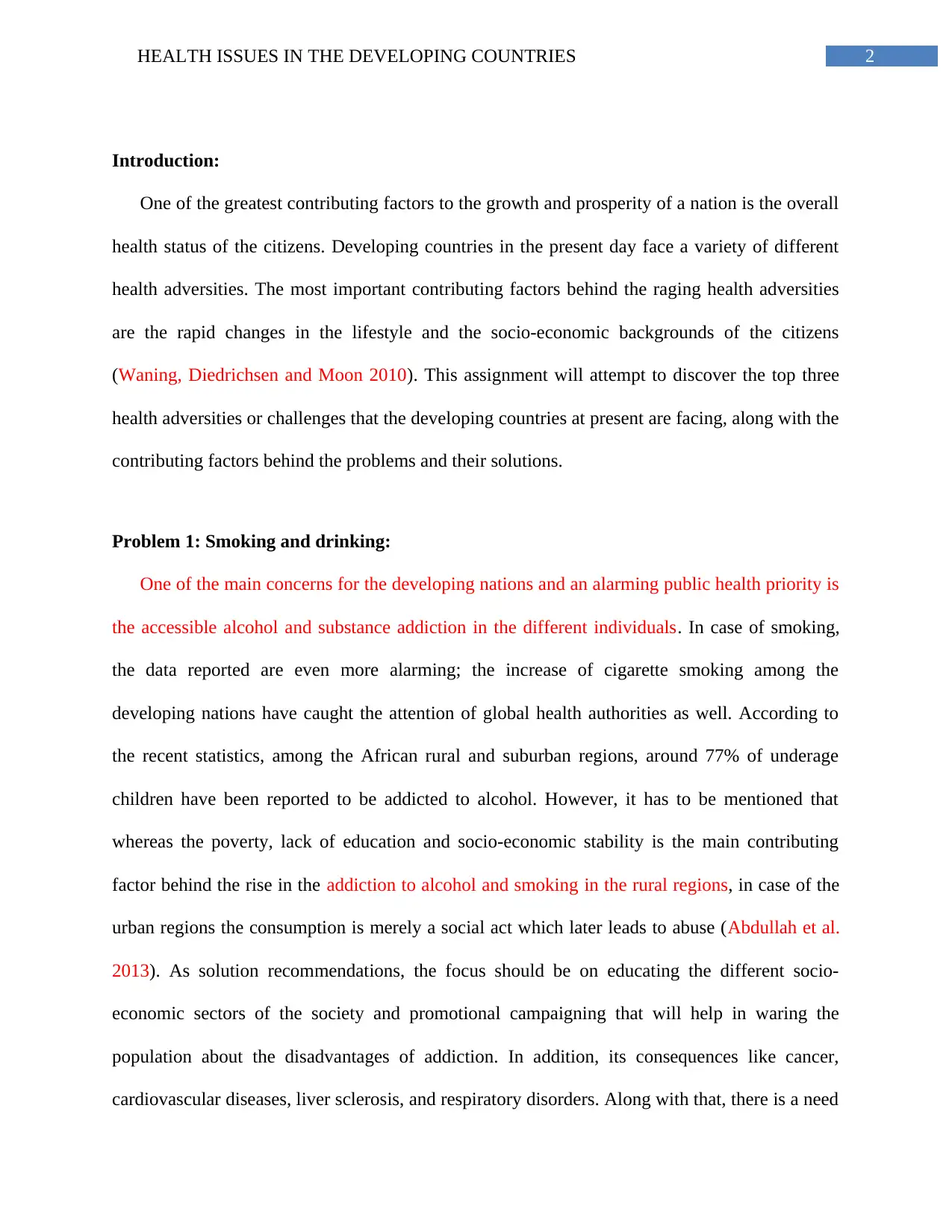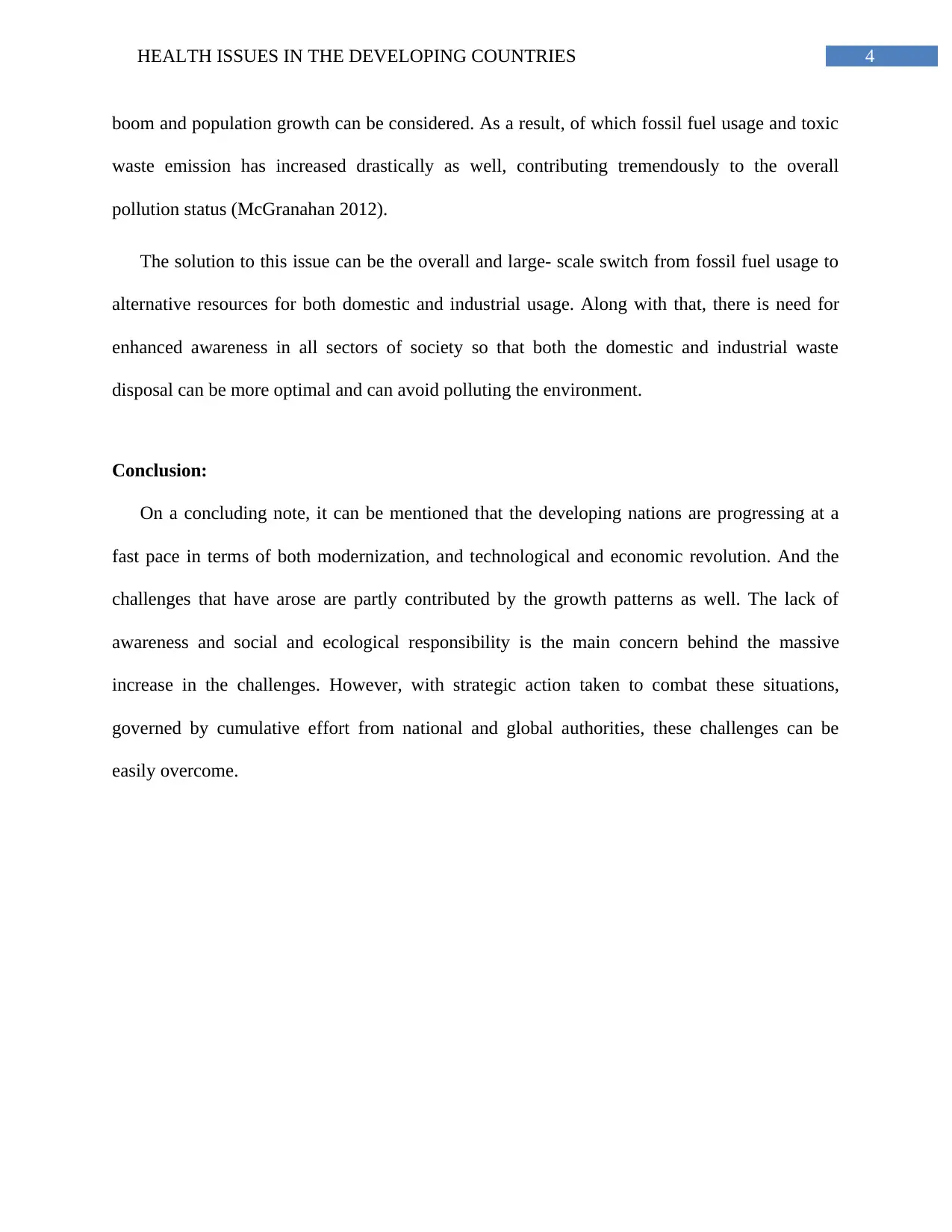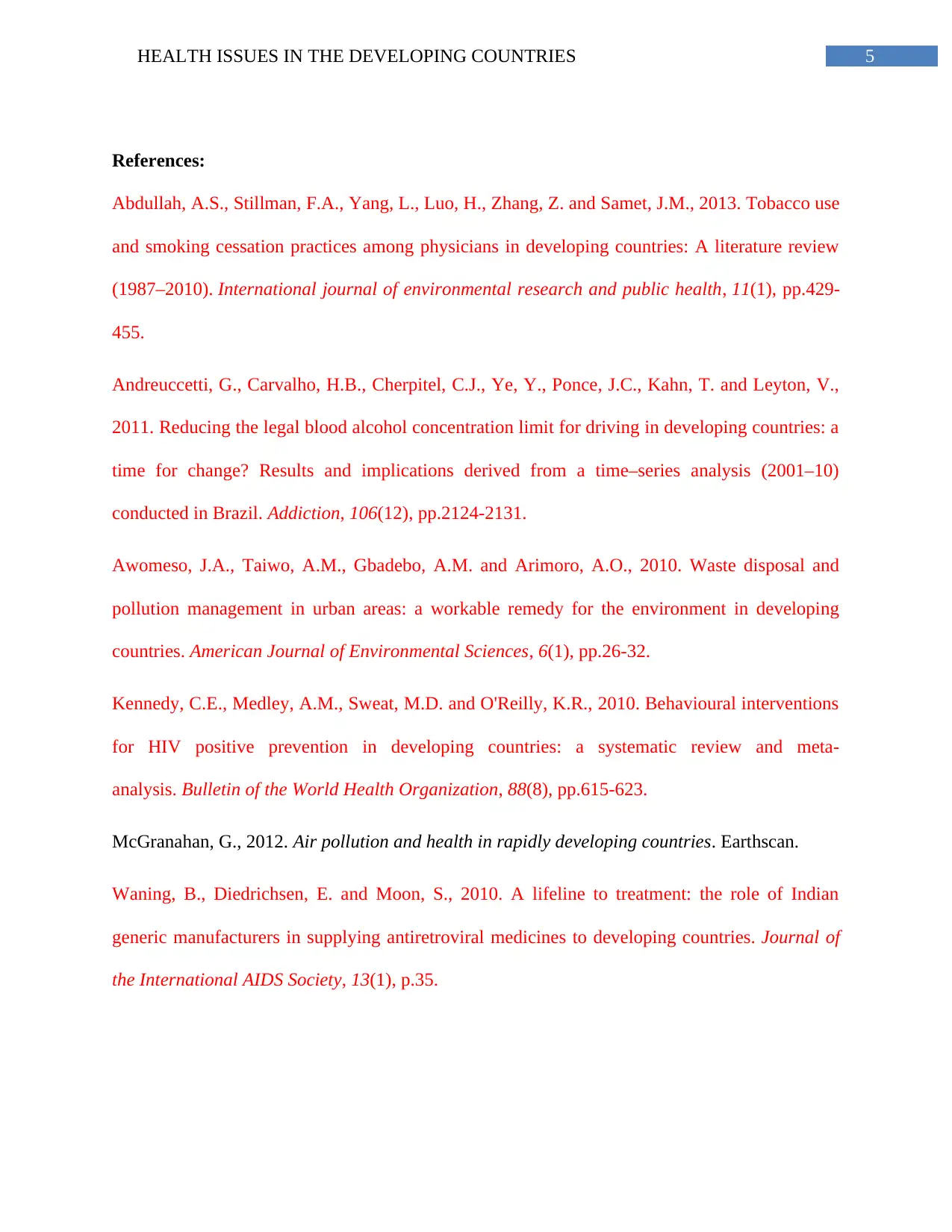Analysis of Health Issues, Challenges in Developing Countries: Report
VerifiedAdded on 2020/05/16
|6
|1200
|169
Report
AI Summary
This report examines the critical health issues prevalent in developing countries, focusing on smoking and drinking, HIV/AIDS, and pollution. The assignment highlights the alarming rates of alcohol and substance addiction, particularly among youth, and the impact of smoking, emphasizing the need for education and awareness campaigns. It also addresses the escalating HIV/AIDS rates, especially in Sub-Saharan Africa, linking it to lack of literacy and unsafe practices, and proposes awareness programs as a solution. Furthermore, the report discusses the detrimental effects of pollution, including respiratory illnesses and skin diseases, caused by industrial growth and population increase, suggesting a shift to alternative resources and improved waste disposal. The report underscores the role of awareness and social responsibility in overcoming these challenges, advocating for strategic actions by national and global authorities.

Running head: HEALTH ISSUES IN THE DEVELOPING COUNTRIES
Health issues in the developing countries
Name of the student:
Name of the university:
Author note:
Health issues in the developing countries
Name of the student:
Name of the university:
Author note:
Paraphrase This Document
Need a fresh take? Get an instant paraphrase of this document with our AI Paraphraser

1HEALTH ISSUES IN THE DEVELOPING COUNTRIES
Table of Contents
Introduction: 2
Problem 1: Smoking and drinking: 2
Problem 2: HIV/AIDS: 3
Problem 3: Pollution: 3
Conclusion: 4
References: 5
Table of Contents
Introduction: 2
Problem 1: Smoking and drinking: 2
Problem 2: HIV/AIDS: 3
Problem 3: Pollution: 3
Conclusion: 4
References: 5

2HEALTH ISSUES IN THE DEVELOPING COUNTRIES
Introduction:
One of the greatest contributing factors to the growth and prosperity of a nation is the overall
health status of the citizens. Developing countries in the present day face a variety of different
health adversities. The most important contributing factors behind the raging health adversities
are the rapid changes in the lifestyle and the socio-economic backgrounds of the citizens
(Waning, Diedrichsen and Moon 2010). This assignment will attempt to discover the top three
health adversities or challenges that the developing countries at present are facing, along with the
contributing factors behind the problems and their solutions.
Problem 1: Smoking and drinking:
One of the main concerns for the developing nations and an alarming public health priority is
the accessible alcohol and substance addiction in the different individuals. In case of smoking,
the data reported are even more alarming; the increase of cigarette smoking among the
developing nations have caught the attention of global health authorities as well. According to
the recent statistics, among the African rural and suburban regions, around 77% of underage
children have been reported to be addicted to alcohol. However, it has to be mentioned that
whereas the poverty, lack of education and socio-economic stability is the main contributing
factor behind the rise in the addiction to alcohol and smoking in the rural regions, in case of the
urban regions the consumption is merely a social act which later leads to abuse (Abdullah et al.
2013). As solution recommendations, the focus should be on educating the different socio-
economic sectors of the society and promotional campaigning that will help in waring the
population about the disadvantages of addiction. In addition, its consequences like cancer,
cardiovascular diseases, liver sclerosis, and respiratory disorders. Along with that, there is a need
Introduction:
One of the greatest contributing factors to the growth and prosperity of a nation is the overall
health status of the citizens. Developing countries in the present day face a variety of different
health adversities. The most important contributing factors behind the raging health adversities
are the rapid changes in the lifestyle and the socio-economic backgrounds of the citizens
(Waning, Diedrichsen and Moon 2010). This assignment will attempt to discover the top three
health adversities or challenges that the developing countries at present are facing, along with the
contributing factors behind the problems and their solutions.
Problem 1: Smoking and drinking:
One of the main concerns for the developing nations and an alarming public health priority is
the accessible alcohol and substance addiction in the different individuals. In case of smoking,
the data reported are even more alarming; the increase of cigarette smoking among the
developing nations have caught the attention of global health authorities as well. According to
the recent statistics, among the African rural and suburban regions, around 77% of underage
children have been reported to be addicted to alcohol. However, it has to be mentioned that
whereas the poverty, lack of education and socio-economic stability is the main contributing
factor behind the rise in the addiction to alcohol and smoking in the rural regions, in case of the
urban regions the consumption is merely a social act which later leads to abuse (Abdullah et al.
2013). As solution recommendations, the focus should be on educating the different socio-
economic sectors of the society and promotional campaigning that will help in waring the
population about the disadvantages of addiction. In addition, its consequences like cancer,
cardiovascular diseases, liver sclerosis, and respiratory disorders. Along with that, there is a need
⊘ This is a preview!⊘
Do you want full access?
Subscribe today to unlock all pages.

Trusted by 1+ million students worldwide

3HEALTH ISSUES IN THE DEVELOPING COUNTRIES
for improving the infrastructure so that all the different socio-economic sectors of the society can
have equal access to health and social services to overcome the addiction (Abdullah et al. 2013).
Problem 2: HIV/AIDS:
Another very common concern for the developing countries that has been rising effectively
has been the increasingly escalating rate of HIV and AIDs. The most common reasons behind the
growing rates are the lack of literacy in the youth regarding protected intercourse and escalating
use of same needle usage in the injection drug users. Among all the other developing countries,
the remote regions of the sub-Saharan Africa are the under the most threat due to communicable
disease outbreaks due to unhygienic and unprotected lifestyle and care delivery conditions
(Kennedy et al. 2010).
The solution strategies for reducing the concern must focus on awareness and health literacy
campaigns. It has to be understood that the lack of literacy regrading the communicable diseases,
and preventative as well as promotional campaigning for all socio-economic sectors of the
society can be extremely beneficial.
Problem 3: Pollution:
The greatest threat to the health and wellbeing of the developing countries has to be the
growing pollution in both the rural and urban regions. It has to be understood that the impact of
pollution is immense and the ever rising global warming is a conspicuous proof of that. On a
more elaborative and specific note, the impact of extreme pollution and increasing abundance of
SPM or suspended particulate matter in the air has become one of the greatest reasons behind the
respiratory concerns and skin diseases in the citizens (Awomeso et al. 2010). Considering the
contributing factor behind the rising pollution in the developing countries, the abrupt industrial
for improving the infrastructure so that all the different socio-economic sectors of the society can
have equal access to health and social services to overcome the addiction (Abdullah et al. 2013).
Problem 2: HIV/AIDS:
Another very common concern for the developing countries that has been rising effectively
has been the increasingly escalating rate of HIV and AIDs. The most common reasons behind the
growing rates are the lack of literacy in the youth regarding protected intercourse and escalating
use of same needle usage in the injection drug users. Among all the other developing countries,
the remote regions of the sub-Saharan Africa are the under the most threat due to communicable
disease outbreaks due to unhygienic and unprotected lifestyle and care delivery conditions
(Kennedy et al. 2010).
The solution strategies for reducing the concern must focus on awareness and health literacy
campaigns. It has to be understood that the lack of literacy regrading the communicable diseases,
and preventative as well as promotional campaigning for all socio-economic sectors of the
society can be extremely beneficial.
Problem 3: Pollution:
The greatest threat to the health and wellbeing of the developing countries has to be the
growing pollution in both the rural and urban regions. It has to be understood that the impact of
pollution is immense and the ever rising global warming is a conspicuous proof of that. On a
more elaborative and specific note, the impact of extreme pollution and increasing abundance of
SPM or suspended particulate matter in the air has become one of the greatest reasons behind the
respiratory concerns and skin diseases in the citizens (Awomeso et al. 2010). Considering the
contributing factor behind the rising pollution in the developing countries, the abrupt industrial
Paraphrase This Document
Need a fresh take? Get an instant paraphrase of this document with our AI Paraphraser

4HEALTH ISSUES IN THE DEVELOPING COUNTRIES
boom and population growth can be considered. As a result, of which fossil fuel usage and toxic
waste emission has increased drastically as well, contributing tremendously to the overall
pollution status (McGranahan 2012).
The solution to this issue can be the overall and large- scale switch from fossil fuel usage to
alternative resources for both domestic and industrial usage. Along with that, there is need for
enhanced awareness in all sectors of society so that both the domestic and industrial waste
disposal can be more optimal and can avoid polluting the environment.
Conclusion:
On a concluding note, it can be mentioned that the developing nations are progressing at a
fast pace in terms of both modernization, and technological and economic revolution. And the
challenges that have arose are partly contributed by the growth patterns as well. The lack of
awareness and social and ecological responsibility is the main concern behind the massive
increase in the challenges. However, with strategic action taken to combat these situations,
governed by cumulative effort from national and global authorities, these challenges can be
easily overcome.
boom and population growth can be considered. As a result, of which fossil fuel usage and toxic
waste emission has increased drastically as well, contributing tremendously to the overall
pollution status (McGranahan 2012).
The solution to this issue can be the overall and large- scale switch from fossil fuel usage to
alternative resources for both domestic and industrial usage. Along with that, there is need for
enhanced awareness in all sectors of society so that both the domestic and industrial waste
disposal can be more optimal and can avoid polluting the environment.
Conclusion:
On a concluding note, it can be mentioned that the developing nations are progressing at a
fast pace in terms of both modernization, and technological and economic revolution. And the
challenges that have arose are partly contributed by the growth patterns as well. The lack of
awareness and social and ecological responsibility is the main concern behind the massive
increase in the challenges. However, with strategic action taken to combat these situations,
governed by cumulative effort from national and global authorities, these challenges can be
easily overcome.

5HEALTH ISSUES IN THE DEVELOPING COUNTRIES
References:
Abdullah, A.S., Stillman, F.A., Yang, L., Luo, H., Zhang, Z. and Samet, J.M., 2013. Tobacco use
and smoking cessation practices among physicians in developing countries: A literature review
(1987–2010). International journal of environmental research and public health, 11(1), pp.429-
455.
Andreuccetti, G., Carvalho, H.B., Cherpitel, C.J., Ye, Y., Ponce, J.C., Kahn, T. and Leyton, V.,
2011. Reducing the legal blood alcohol concentration limit for driving in developing countries: a
time for change? Results and implications derived from a time–series analysis (2001–10)
conducted in Brazil. Addiction, 106(12), pp.2124-2131.
Awomeso, J.A., Taiwo, A.M., Gbadebo, A.M. and Arimoro, A.O., 2010. Waste disposal and
pollution management in urban areas: a workable remedy for the environment in developing
countries. American Journal of Environmental Sciences, 6(1), pp.26-32.
Kennedy, C.E., Medley, A.M., Sweat, M.D. and O'Reilly, K.R., 2010. Behavioural interventions
for HIV positive prevention in developing countries: a systematic review and meta-
analysis. Bulletin of the World Health Organization, 88(8), pp.615-623.
McGranahan, G., 2012. Air pollution and health in rapidly developing countries. Earthscan.
Waning, B., Diedrichsen, E. and Moon, S., 2010. A lifeline to treatment: the role of Indian
generic manufacturers in supplying antiretroviral medicines to developing countries. Journal of
the International AIDS Society, 13(1), p.35.
References:
Abdullah, A.S., Stillman, F.A., Yang, L., Luo, H., Zhang, Z. and Samet, J.M., 2013. Tobacco use
and smoking cessation practices among physicians in developing countries: A literature review
(1987–2010). International journal of environmental research and public health, 11(1), pp.429-
455.
Andreuccetti, G., Carvalho, H.B., Cherpitel, C.J., Ye, Y., Ponce, J.C., Kahn, T. and Leyton, V.,
2011. Reducing the legal blood alcohol concentration limit for driving in developing countries: a
time for change? Results and implications derived from a time–series analysis (2001–10)
conducted in Brazil. Addiction, 106(12), pp.2124-2131.
Awomeso, J.A., Taiwo, A.M., Gbadebo, A.M. and Arimoro, A.O., 2010. Waste disposal and
pollution management in urban areas: a workable remedy for the environment in developing
countries. American Journal of Environmental Sciences, 6(1), pp.26-32.
Kennedy, C.E., Medley, A.M., Sweat, M.D. and O'Reilly, K.R., 2010. Behavioural interventions
for HIV positive prevention in developing countries: a systematic review and meta-
analysis. Bulletin of the World Health Organization, 88(8), pp.615-623.
McGranahan, G., 2012. Air pollution and health in rapidly developing countries. Earthscan.
Waning, B., Diedrichsen, E. and Moon, S., 2010. A lifeline to treatment: the role of Indian
generic manufacturers in supplying antiretroviral medicines to developing countries. Journal of
the International AIDS Society, 13(1), p.35.
⊘ This is a preview!⊘
Do you want full access?
Subscribe today to unlock all pages.

Trusted by 1+ million students worldwide
1 out of 6
Related Documents
Your All-in-One AI-Powered Toolkit for Academic Success.
+13062052269
info@desklib.com
Available 24*7 on WhatsApp / Email
![[object Object]](/_next/static/media/star-bottom.7253800d.svg)
Unlock your academic potential
Copyright © 2020–2025 A2Z Services. All Rights Reserved. Developed and managed by ZUCOL.





